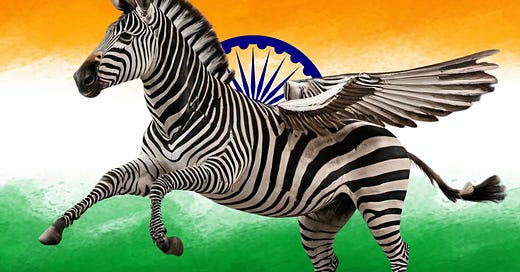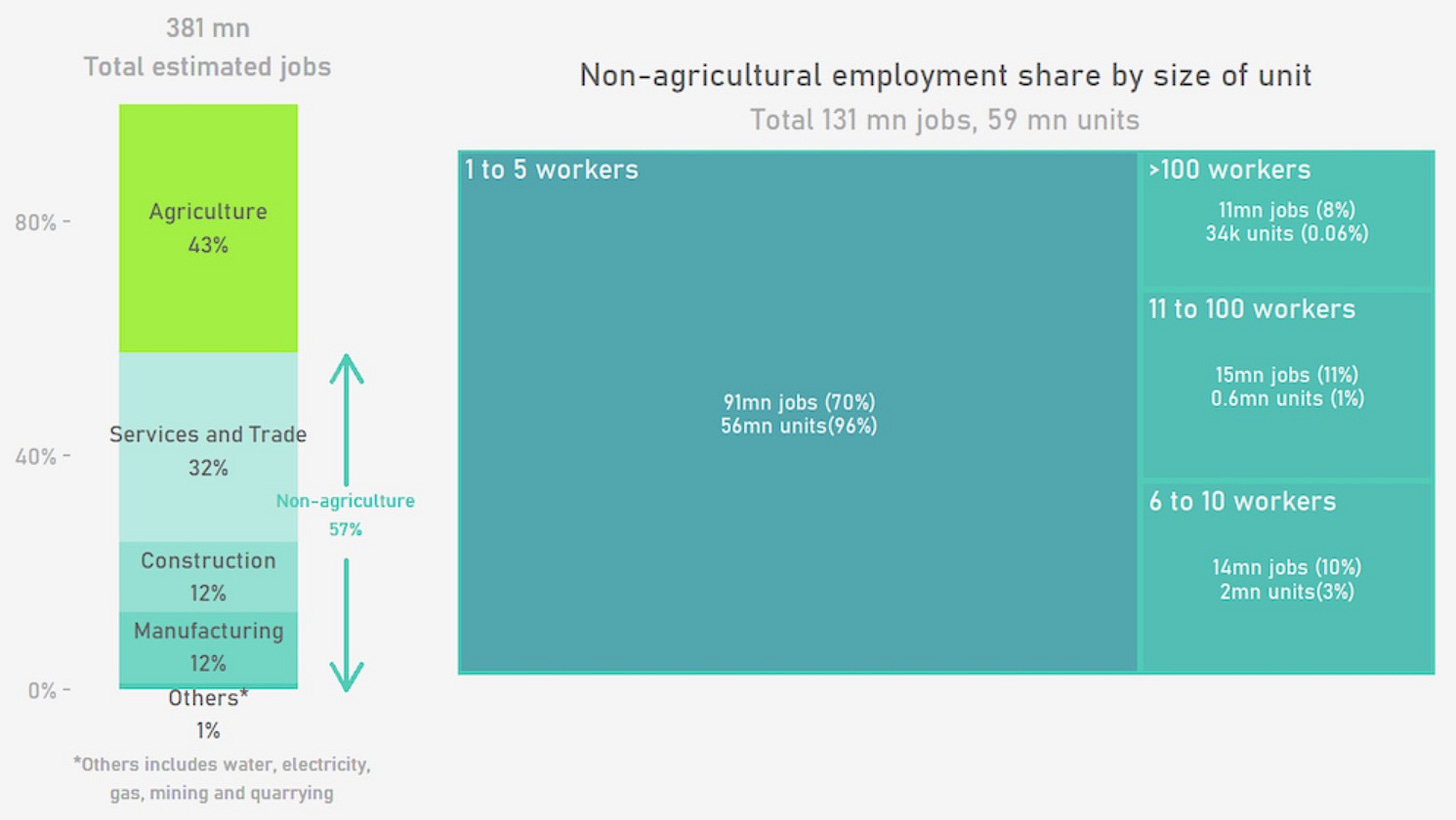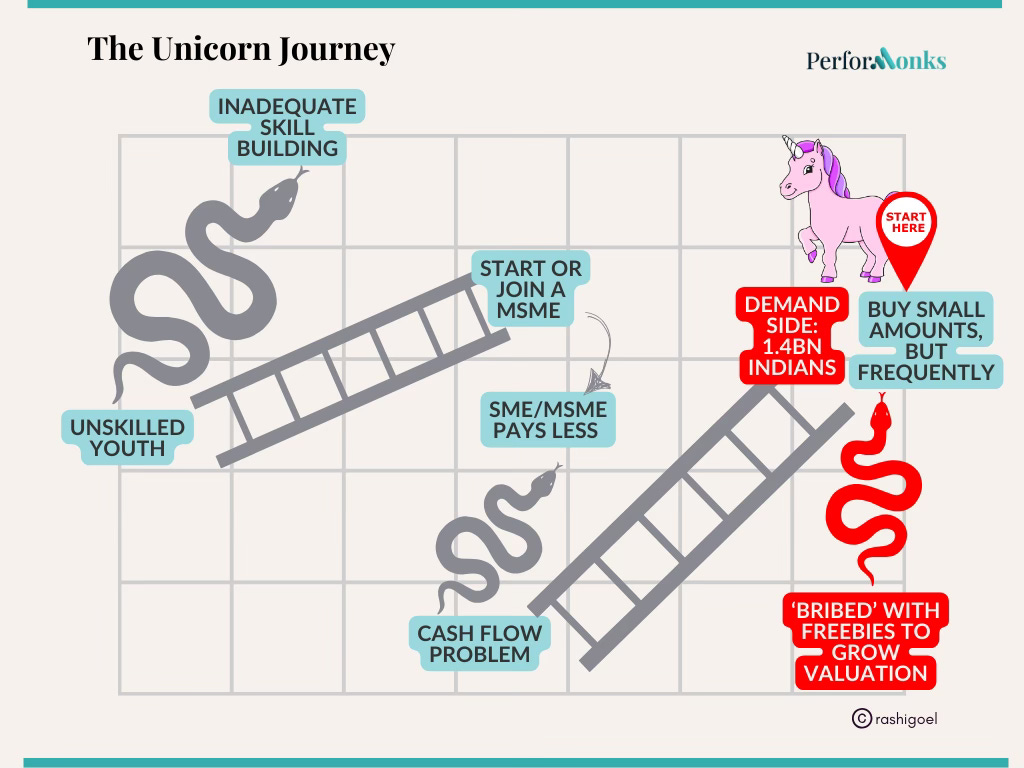Practical ideas on marketing strategy and self-mastery they don’t teach in B-school. Performonks goes to 5,598 curious marketers and founders - join the tribe.
Unicorn companies chase big valuations and are short-termists.
Zebra companies chase win-win business models and are long-termists.
I think India needs more bottom-up growth and less top-down growth thrust upon it.
Zebra companies could be the answer.
If, along the way, a Zebra company becomes a unicorn, who am I to stop them?
This edition covers:
Why India needs more Zebras.
Popular Zebra models in the west - consortium, community, crowdfunder, and conscientious.
A Zebra model that is native to India.
Let’s go.
India struggles both on the supply and demand side
Supply-side: our demographic dividend has become a liability.
I was driving to the Jolly Grant airport (Dehradun) last Saturday. It was 7:45 AM. As we entered the main market square, we saw hundreds of men. Men on their haunches, men walking around, men waiting.
They were daily wage earners, waiting for a job. Any job. Painting a house, laying bricks, carrying a heavy package from one place to the next, or loading a truck.
If they didn’t get a job that day, they most likely went to bed hungry.
Travel into any big city and you will see the same scenario play out each morning.
We have possibly the highest concentration of able-bodied, working-class men and women in the world but no steady jobs.
You might say the solution lies in education.
I thought so too until I connected different data sources and saw that even the educated are unemployable.
This means that only 2 out of the 6 working-age people are employable.
The rest are in unskilled jobs3, running their own small business, or joining a small company.
Small enterprises dominate the economy.
In the 2013-14 economic census, there were 59 million non-agricultural establishments that employed 131 million persons.
The aggregated power of small numbers shows up here - these MSMEs contribute ~30% of India’s GDP and 45% of its manufacturing output.
Small means really small.
96% of these were very small units with 1-5 workers, employing 70% of the 131 million.
Do you know how many of these were large enterprises with >100 employees? Only 0.06%. And they employed 8% of the 131 million.
All this has a knockdown effect on consumption.
Unskilled workers become cash-poor consumers.
Informal jobs and MSMEs don’t pay enough for a luxurious lifestyle. Let me correct myself. They don’t even pay enough to be middle-class by global living standards.
That’s why the average Indian has a cash flow problem. This means that we buy small amounts over many purchase occasions.
In this peculiar game of snakes and ladders, enter the unicorns.
Unicorns start at the consumption end of the game.
They are shocked when what they thought was a ladder becomes a poisonous snake.
They believe a population of 1.4 billion will get them to a billion-dollar valuation within 3 years or less.
But the revenues don’t flow. And they realize that they only have two options:
operate within the top 1% of India, where they face a dual challenge-
how to differentiate meaningfully?
how to grow demand? (after all, how many healthy breakfast cereals can the top 1% consume?)
target the next 19%. Here, many many people consume a little bit over time. Do you remember Thayyal Nayagi from a previous newsletter? She has to jujitsu her way into solvency every month.
Unicorns are therefore, forced to ‘buy’ sales through freebies and discounts. They build businesses where their biggest skill, instead of making profits, is storytelling.
That’s why only 31/100 unicorns were profitable in FY22.
On the other hand, what do Zebras do?
Zebras start at the supply side and create demand.
They infuse buying power into the market by training and putting people to work. These people become the consuming class and start a virtuous cycle of upward mobility.
So what are Zebra business models, and which one is best suited for India?
There are four types of Zebra models in the West. But there is one native to India that would be perfect for our peculiarities.
First, the four western Zebra models:
1) The consortium: SEMATECH
In the 1980s, all semiconductor manufacturers in the US started losing share to Japanese companies, that made more advanced semiconductors. 14 American semiconductor companies got together and created SEMATECH, a consortium that competed together and won the market back.
2) The community: Linux
Open source is the epitome of Zebra economies. Take Linux or Wikipedia. Their power does not come from one person or a monopoly status. It comes from thousands of contributors working together.
3) The crowdfunder: Patreon, Kickstarter
Patreon has built a system where 6 million Patreon viewers make monthly donations to more than 200,000 creators. Kickstarter is another platform where money circulates to help those in need.
4) The conscientious: Buffer
Buffer bought out its investors because it wanted to pursue sustainable growth, not bloated topline.
The Zebra model native to India draws its strength from numbers at the supply end.
The collective: Amul, Zoho Books, Iron Chusti, Shakti Amma
Travel-commerce, Food-commerce, E-Commerce, Q-commerce, and Urban Company, all upskill and hire.
But what if this were to go geographically deeper? I mean, make-in-rural-sell-in-urban deep? We all know about Amul and Unilever’s Project Shakti. I want to briefly talk about Zoho and PepsiCo.
Zoho
They upskill and hire youth in small cities and villages of Tamil Nadu. While this bolsters the demand side of the economy in general, it is also good for business— reduced attrition and lower employee costs.
PepsiCo’s Lehar Iron Chusti
From 2009 to 2012, I set up a business selling Rs.2/—iron-fortified biscuits and snacks in rural Andhra Pradesh.
While we started by manufacturing the products at a local co-packer, our end goal was to set up local manufacturing units, managed by women entrepreneurs trained by Pepsico, to produce iron-fortified packaged food—snacks, biscuits, and bread.
These were to be sold locally and in urban areas. Sadly, PepsiCo did not have the appetite to see this plan through.
When the tide goes up, it lifts all boats from the tiniest dinghy to the cruise ship as big as Gibraltar. But when all boats are tied together, they don’t need to wait for the tide and can cross the chasm together.
May a billion Zebras bloom in India.
https://mospi.gov.in/sites/default/files/reports_and_publication/statistical_publication/social_statistics/WM16Chapter3.pdf
India 2021 skills report: The India Skills Report 2021 shows that only 50% of the formally educated are employable. About 47% of B Tech, 47% of MBA, 43% of BA, 40% of B Com and 30% of BSc graduates had employable skills. Only 22% of MCA degree holders could be considered employable. About 75% of ITI graduates did not possess employable skills. Unemployability among our B Pharma graduates was at 67%. Adding other sectors too, it was estimated that 65% to 75% of the 15 million young people who enter the labour market every year are unemployable.
CMIE’s 2021 data shows that by end of July 2021 the unemployment rate had risen to 6.95% with 8.3% unemployment in urban areas and 6.4% in rural India. The Labour Force Participation Rate showed a rise of just 0.6% – 39.5 to 40.1 – from June to July. A large portion of even that tiny increase was actually in unskilled, low paying, low productivity jobs in the agriculture sector. And July is the season when agriculture temporarily absorbs a huge labour force. Once the season is over, however, these jobs disappear.https://mospi.gov.in/sites/default/files/reports_and_publication/statistical_publication/social_statistics/WM16Chapter3.pdf
https://scroll.in/article/1048747/what-does-the-data-say-about-indias-unemployed-unemployable-and-unskilled-young-labour-force









